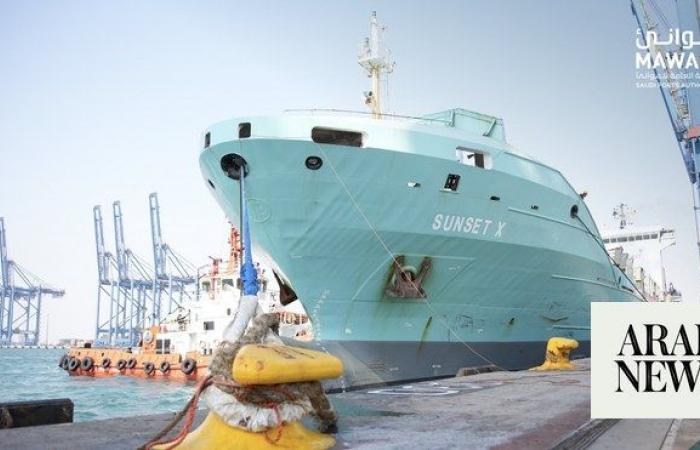Thank you for reading the news about Folk Maritime shipping line receives first vessel at Jeddah Port and now with the details
Jeddah - Yasmine El Tohamy - Saudi banks’ deposits reach $677bn in February, reflecting economic resilience
RIYADH: Saudi banks’ total deposits reached SR2.54 trillion ($677 billion) in February, marking a 10.26 percent increase from the same month last year, the official data showed.
Analysis conducted on the data released by the Saudi Central Bank confirmed that growth was primarily fueled by a 26 percent annual increase in time and savings deposits, which reached SR838.53 billion.
Demand reserves also saw a 2.85 percent rise during this period, totaling SR1.25 trillion, while other quasi-money increased by 7.57 percent, reaching SR352 billion.
Demand deposits constitute the highest share at 53 percent, slightly down from 57 percent a year ago. This shift is a result of the increasing popularity of term reserves due to rising interest rates, making this account category more attractive to clients seeking higher income-generating holdings.
However, term deposits experienced a 3 percent decrease month-on-month, the first decline in 18 months.
The rising interest rate bolstered the popularity of term deposits during this period, as they were increasing in alignment with the US Fed rates as part of recent monetary policy efforts to combat inflation. However, this upward trend appears to be approaching its end, given the Fed’s decision to maintain rates unchanged in their latest meeting in March. The last hike took place in July 2023.
Meanwhile, Saudi Arabia has displayed remarkable resilience and stability in managing inflation. This success can be credited to the steadfast implementation of robust government policies aimed at safeguarding the economy. However, the country’s currency pegged to the US dollar means the central bank closely follows the Fed interest rate movement.
Among term deposits, the segment that witnessed the highest growth was from businesses and individuals, increasing by 36 percent during this period to reach SR450 billion. In contrast, government entities saw a rise of 16.4 percent, reaching SR388.15 billion.
Despite the increase in bank deposits, the growth in loans has exceeded the liability side, putting pressure on the support for the expanding local economy.
MEED Projects, a Dubai-based analysis firm, forecasts that Saudi Arabia will need $640 billion for construction spending over the next five years, based on current project pipelines.
This implies that banks potentially have to raise nearly $384 billion over this period if they fund 60 percent of the initiatives through increased deposits and debt.
Although the growth in Saudi Arabia’s reserves remains a key funding source, about 15 percent of the required amount may have to be sourced from debt, according to Edmond Christou, a senior financial analyst at Bloomberg Intelligence, in an April report. This could mean issuing new debt of approximately $11.5 billion annually.
Christou also noted that financial institutes currently need more liquidity to fully support the significant construction needs, but they anticipate gathering more deposits and accessing the international debt market.
Debt issuance is already increasing, with approximately $6.8 billion sold just this year, compared to $5.4 billion for the entire previous year, as reported by Bloomberg Intelligence.
Despite the ambitious funding needs, the balance sheets of Saudi Arabia’s banks are generally viewed as healthy, according to the report. S&P Global Ratings categorizes most major lenders as investment grade with a stable outlook. However, S&P also points out that these financial institutions will not be able to carry the full financial burden of Vision 2030, the country’s long-term economic development plan.
According to Bloomberg’s report, projects are also largely funded by the central government and associated entities. The well-financed Public Investment Fund has announced intentions to invest $70 billion annually after 2025 and is considering its own fundraising strategies.
The analysis indicated there is still some time before banks venture into the fixed-income market, especially as liquidity has been showing signs of improvement since the beginning of the year.
This is evidenced by Saibor, a significant indicator of borrowing costs in Saudi Arabia, easing back from the 6.4 percent peak in January. However, it remains considerably above 6 percent due to elevated rates in the US.
These were the details of the news Folk Maritime shipping line receives first vessel at Jeddah Port for this day. We hope that we have succeeded by giving you the full details and information. To follow all our news, you can subscribe to the alerts system or to one of our different systems to provide you with all that is new.
It is also worth noting that the original news has been published and is available at Arab News and the editorial team at AlKhaleej Today has confirmed it and it has been modified, and it may have been completely transferred or quoted from it and you can read and follow this news from its main source.

